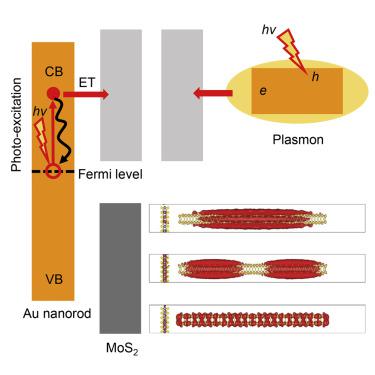Chem ( IF 23.5 ) Pub Date : 2018-03-29 , DOI: 10.1016/j.chempr.2018.02.025 Zhaosheng Zhang , Lihong Liu , Wei-Hai Fang , Run Long , Marina V. Tokina , Oleg V. Prezhdo

|
Using nonadiabatic molecular dynamics simulations combined with time-domain density functional theory, we show that electron injection from gold nanorods into MoS2 by the traditional mechanism is still faster than energy relaxation causing charge recombination. Plasmon-like excitations decay into free-electron states within 30 fs after photoexcitation of gold nanorods. Electron transfer follows within less than 100 fs, whereas energy relaxation requires 200 fs. Surface plasmons couple to low-frequency phonons of gold, and free charges also couple to higher-frequency phonons of gold and MoS2. The contribution of the charge-transfer photoexcitation mechanism to plasmon-driven charge separation depends strongly on the type of donor-acceptor interaction, e.g., chemical versus van der Waals, and more weakly on contact area and system geometry. The simulation generates a detailed time-domain atomistic description of the interfacial plasmon-driven charge separation and relaxation that are fundamental to many applications.
中文翻译:

从金纳米棒等离子注入电子到MoS 2:传统与光激发机制。
使用非绝热分子动力学模拟与时域密度泛函理论相结合,我们表明,通过传统机理将电子从金纳米棒注入MoS 2的速度仍然快于引起电荷复合的能量弛豫。在金纳米棒光激发后的30 fs内,等离激元样的激发衰减为自由电子态。电子转移在不到100 fs的范围内进行,而能量弛豫则需要200 fs。表面等离子体激元耦合到金的低频声子,自由电荷也耦合到金和MoS 2的高频声子。。电荷转移光激发机制对等离激元驱动的电荷分离的贡献在很大程度上取决于供体-受体相互作用的类型,例如化学对范德华力,而在更弱的程度上取决于接触面积和系统几何形状。仿真生成了界面等离激元驱动的电荷分离和弛豫的详细时域原子描述,这是许多应用程序所必需的。


























 京公网安备 11010802027423号
京公网安备 11010802027423号